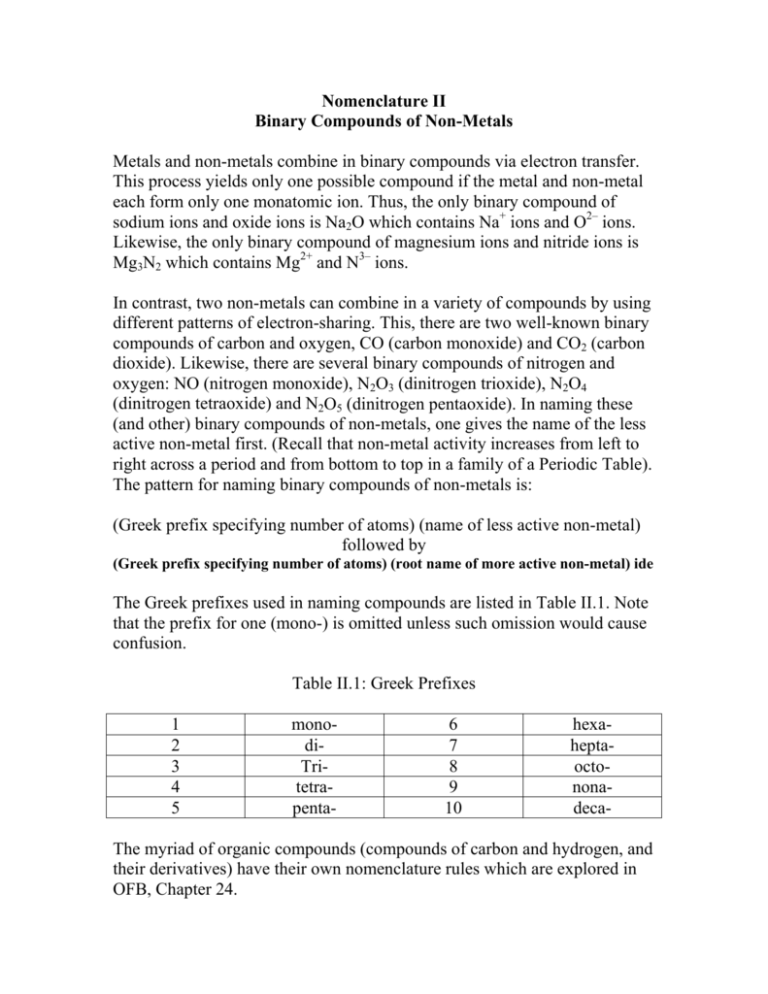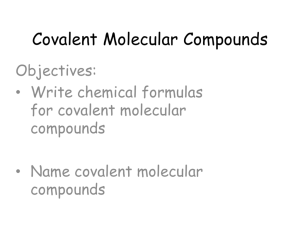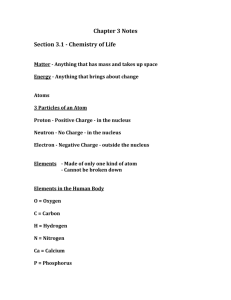Nomenclature II
advertisement

Nomenclature II Binary Compounds of Non-Metals Metals and non-metals combine in binary compounds via electron transfer. This process yields only one possible compound if the metal and non-metal each form only one monatomic ion. Thus, the only binary compound of sodium ions and oxide ions is Na2O which contains Na+ ions and O2– ions. Likewise, the only binary compound of magnesium ions and nitride ions is Mg3N2 which contains Mg2+ and N3– ions. In contrast, two non-metals can combine in a variety of compounds by using different patterns of electron-sharing. This, there are two well-known binary compounds of carbon and oxygen, CO (carbon monoxide) and CO2 (carbon dioxide). Likewise, there are several binary compounds of nitrogen and oxygen: NO (nitrogen monoxide), N2O3 (dinitrogen trioxide), N2O4 (dinitrogen tetraoxide) and N2O5 (dinitrogen pentaoxide). In naming these (and other) binary compounds of non-metals, one gives the name of the less active non-metal first. (Recall that non-metal activity increases from left to right across a period and from bottom to top in a family of a Periodic Table). The pattern for naming binary compounds of non-metals is: (Greek prefix specifying number of atoms) (name of less active non-metal) followed by (Greek prefix specifying number of atoms) (root name of more active non-metal) ide The Greek prefixes used in naming compounds are listed in Table II.1. Note that the prefix for one (mono-) is omitted unless such omission would cause confusion. Table II.1: Greek Prefixes 1 2 3 4 5 monodiTritetrapenta- 6 7 8 9 10 hexaheptaoctononadeca- The myriad of organic compounds (compounds of carbon and hydrogen, and their derivatives) have their own nomenclature rules which are explored in OFB, Chapter 24. Exercises 1. Name the compounds identified below. a. b. c. d. e. f. g. h. i. CCl4 SO3 As4O6 XeF4 P4O10 Cl2O7 SiO2 NF3 CF4 j. SO2 k. As4O10 l. XeF2 m. P4O6 n. Cl2O5 o. SiH2 p. NI3 2. Give the correct formula for each compound named below. a. hydrogen fluoride b. sulfur hexachloride c. fluorine triiodide d. oxygen difluoride e. sulfur dioxide f. hydrogen sulfide g. xenon heptafluoride h. kyrpton trioxide i. hydrogen iodide j. sulfur tetrafluoride k. chlorine monofluoride l. sulfur dichloride m. iodine tribromide n. xenon trioxide o. selenium dichloride




